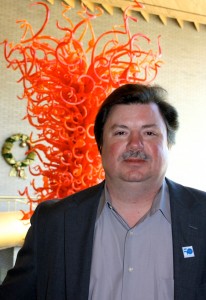There has been a lot of talk in recent years about the precarious situation symphony orchestras in the United States have found themselves in. And since the recession the public discussion has turned even more pessimistic, with many people convinced that orchestras will soon be a thing of the past.
While it is true that a number of organizations have experienced significant financial problems, with a number of them going under, the majority has survived – and, in fact, have been thriving. To rephrase Mark Twain’s famous comment, the report on the demise of the symphony orchestra has been greatly exaggerated.
That’s what Bruce Ridge firmly believes, and he has the information to back up his claims. Ridge is chairman of the International Conference of Symphony and Opera Musicians (ICSOM), and he wants to change the negative view people have of orchestras in this country. Since becoming chairman in 2006, Ridge has taken it upon himself to visit every single orchestra that’s a member of ICSOM.
Recently he was in Salt Lake City on a trip that also included stops in Denver, to visit the Colorado Symphony, and in Phoenix, to meet with musicians and management of that city’s orchestra. While in Salt Lake City Ridge, who is also a member of the North Carolina Symphony’s bass section, met with Reichel Recommends in Abravanel Hall.
It’s true that several symphony orchestras are struggling, Ridge said, but rather than obsessing with the bad news, everyone should be focusing on the positive stories. “We shouldn’t talk just about the orchestras that are having difficulties,” he said. “Instead we should talk about how many have survived.”
And Ridge has the facts to show that instead of being on the brink of extinction, most orchestras are doing just fine. As examples he cites the Houston and Chicago Symphonies, both of whose fundraising efforts are at record high levels. Other orchestras, such as the Cincinnati Symphony and the San Diego Symphony are enjoying increased ticket sales and high attendance. “Things aren’t as bad as everyone has been saying,” he said.
In fact, prophesying the end of the symphony orchestra isn’t a 21st century phenomenon. It goes back more than half a century. In 1970 there was a story that said 25 orchestras were doomed to die. “In 1969, Time published a story stating that America would lose a third to a half of its orchestras,” Ridge said. Going back even further he said that, “The board chair of the Chicago Symphony made dire predictions about his own orchestra. That was in 1940.” In other words, the current crop of doomsday prophets are just rehashing old material. “I call this the ‘new apocalypticism,’” Ridge said.
No one is denying that there aren’t any problems – Ridge would be the first to admit that there are. And there is a pressing need to solve them. But there is no easy answer, nor is there a formula that fits every orchestra’s issues. “There is no national model to solve problems,” he said. Solutions need to be tailored to the individual orchestra.
A start would be to look at the organizations that are doing well. “People need to examine the orchestras that are thriving and find out how to make it work in their own communities.”
One of the answers to restoring and maintaining the health of an orchestra lies in programming. “Programming is critical,” Ridge said. “People like to attend programs that inspire them. If the audience has a good experience, they’ll come back.” The challenge is finding the right type of programming for a particular orchestra. “What works for one orchestra won’t necessarily work for another.”
Another place where orchestras need to look for answers is marketing, specifically the possibilities that social media offer. “Orchestras haven’t entered the new age of marketing, yet,” Ridge said. What orchestras need to do in this regard is find their target audience. “That target audience is not the traditional audience, it’s the next generation. And you reach out to them through social media like Facebook and Twitter.”
As far as the Utah Symphony goes, Ridge is “excited” about the organization. “This is a historically famous orchestra,” he said. “[Maurice] Abravanel’s recordings and the orchestra are known worldwide. The orchestra is thriving and growing and [the organization] takes pride in what it has.”
Like other orchestras, the Utah Symphony has had its share of financial woes. Management has had to make cutbacks, and musicians have had to make sacrifices in their recent contract negotiations. And while it’s painful, at least the Utah Symphony has avoided the acrimonious labor disputes that have led to the current musician lockouts by the Minnesota Orchestra and the St. Paul Chamber Orchestra. “Nothing is easy,” Ridge said. “But solutions must be found to see what cuts can be restored. Everybody needs to understand that the world of art will have disagreements, but the key is in finding resolutions and in collaboration.”
Despite the difficult times, Ridge is upbeat about the future of symphony orchestras in the United States. “Every place I’ve visited I’ve been inspired by the musicians and by what they do.”
What has to be done to ensure a bright future is to look at the orchestras that are thriving. “The orchestras in Houston, Los Angeles, Cincinnati and Utah – and other cities, too – are successful,” Ridge said. “We need to see what we can learn from them.”

